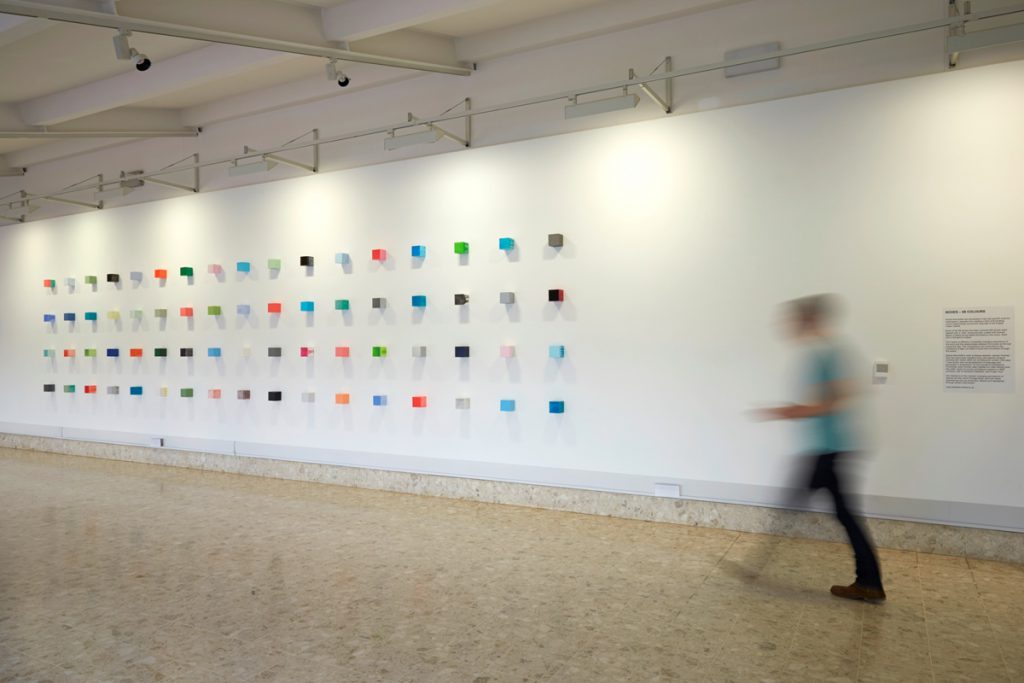Sheila Ravnkilde developed a new site-specific work for Nottingham Lakeside Arts creating a field of fluctuating colour relationships across the long wall of the Angear Visitor Centre. Each of the 68 boxes was covered with acrylic paint applied with a roller. Some were also coated with several layers of glaze giving depth and lustre to the colour. Each unit in the grid was unique. The viewer was offered a constantly changing experience of the work and the relationships between the boxes as the eye scanned the wall. The connections varied according to the conditions of light, the viewer’s field of focus and movement through the space. Sheila Ravnkilde’s work is always abstract, always minimal. She has previously installed many site-specific projects working with colour within an architectural context. She says “I see studio work as development of language and processes in preparation for site-sensitive installations. Processes used include: paint applied by roller directly onto the walls; layers of acrylic paint/glazes applied on MDF surfaces; use of industrial materials; use of sign vinyl.” Her interest is in the viewers’ changing perceptions of spaces as they move through them, and how these experiences can be enhanced, altered and highlighted through artistic intervention.
Review by Tom Hackett in A-N Artists Information Co
Sheila Ravnkilde (solo installation)
Saturday 26 July – Sunday 02 November 2014,
Venue: Angear Visitor Centre, Lakeside Arts Centre, University of Nottingham
Location: East Midlands
For many artists the process or journey is as important as the destination when producing art. The question of destination becomes interesting when applied to the field of ‘minimal’ abstraction which resists narrative and has an intention ‘to be’ in the world rather than mirror it.
The abstract artists I have met over the years have made a kind of ‘pledge’ to pursue abstraction as a sole creative path. For them the ideas of hopping on or off different buses,(like many of us other sorts of artist often do) would be it seems, unthinkable. They toil tirelessly on their quest, while their area of particular focus loops in and out attention of fickle art world attention. This requires a level of commitment akin to faith.
Once you have decided to eliminate ‘content’ as we know it and devote your life to abstraction, how then how do you put your own marker on it? Especially when you chosen forms are the box, its repetition and placement within the grid.
An artist who has managed to find her own artistic voice within this genre and has done so with true aplomb is Sheila Ravnkilde. Even before you enter the door to Angear space at Djanogoly, and simply glance through the window you’re struck by the spatial force of the work. Quite simple it makes the wall resonate with colour and this is before you get up close.
When you enter the space you are met by 68 wall based small 4’ inch coloured cube forms set in an immaculate grid sat at approximately 2ft intervals. In total making a piece over 30ft long. Each block is individually painted. They are linked by scale, proximity and the over-arching grid form, but the colours shift and meander from block to block across a large expanse of white wall, with an elegant sense of rhythm. The work is described as site specific and is clearly, made to take on the space in a physical manner. This is without question, formally succinct placement activating the space in a dynamic manner.
Ravnkilde gives us a master class in colour and it spatial impact when set up in an inter-relational configuration. Sensually vibrant oranges, turquoises and sage greens artfully set off each other. This is to be expected of her work, she always executes colour to a high standard. But I love it when an artist’s work surpasses your hopes for it.
This next level comes through her meticulous sense of textural exploration, surface variation and evident engagement with process as subject. Cracked bubbling surfaces, create an almost biological feel on some squares. Others reveal emphatic black drips redolent of Motherwell. Other have thin colour washes which bleed over the cubes. These varying cube surfaces sit alongside occasional immaculate flat colour minimal squares. These differences create a kind of ‘personality’ to each block. It is this that shunts this into the world of considered fine art rather than say good spatial design. The more textural process driven blocks generating a counterpoint with the immaculate grid and other ‘flat colour’ boxes. This create a rewarding and captivating visual paradox which bewitches and holds the gaze.
Good art for me, is always greater than the sum of its parts and this is a classic illustration of this. This work shows the process and the tight media control of the artist to impressive effect.
I very much like the Robert Louis Stevenson quote ‘to travel hopefully is a better thing than to arrive and the true success is to labour.” Exploring in essence the idea of the journey, not the destination being the ‘thing’. But in this case I would argue the work has both travelled well and arrived with panache. And you cannot really ask for more as a viewer.
http://www.lakesidearts.org.uk/Exhibitions/ViewEvent.html?e=2611&c=5&d=0
Tom Hackett










